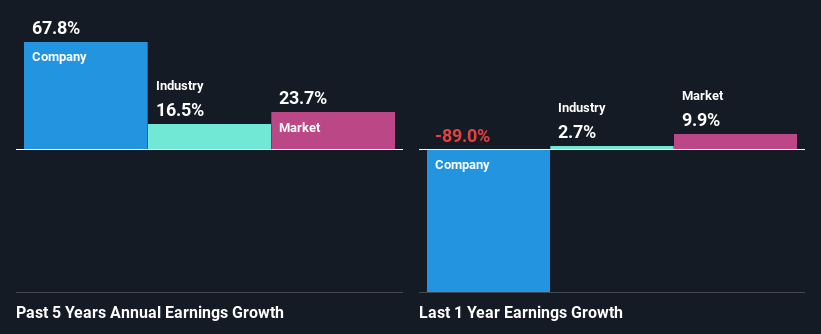- Poland
- /
- Real Estate
- /
- WSE:PRN
Is Partner-Nieruchomosci S.A.'s (WSE:PRN) Recent Stock Performance Influenced By Its Fundamentals In Any Way?
Partner-Nieruchomosci (WSE:PRN) has had a great run on the share market with its stock up by a significant 24% over the last three months. We wonder if and what role the company's financials play in that price change as a company's long-term fundamentals usually dictate market outcomes. In this article, we decided to focus on Partner-Nieruchomosci's ROE.
ROE or return on equity is a useful tool to assess how effectively a company can generate returns on the investment it received from its shareholders. In simpler terms, it measures the profitability of a company in relation to shareholder's equity.
Check out our latest analysis for Partner-Nieruchomosci
How To Calculate Return On Equity?
ROE can be calculated by using the formula:
Return on Equity = Net Profit (from continuing operations) ÷ Shareholders' Equity
So, based on the above formula, the ROE for Partner-Nieruchomosci is:
1.0% = zł35k ÷ zł3.6m (Based on the trailing twelve months to December 2022).
The 'return' is the amount earned after tax over the last twelve months. Another way to think of that is that for every PLN1 worth of equity, the company was able to earn PLN0.01 in profit.
Why Is ROE Important For Earnings Growth?
We have already established that ROE serves as an efficient profit-generating gauge for a company's future earnings. Depending on how much of these profits the company reinvests or "retains", and how effectively it does so, we are then able to assess a company’s earnings growth potential. Generally speaking, other things being equal, firms with a high return on equity and profit retention, have a higher growth rate than firms that don’t share these attributes.
A Side By Side comparison of Partner-Nieruchomosci's Earnings Growth And 1.0% ROE
As you can see, Partner-Nieruchomosci's ROE looks pretty weak. Even when compared to the industry average of 9.5%, the ROE figure is pretty disappointing. Despite this, surprisingly, Partner-Nieruchomosci saw an exceptional 68% net income growth over the past five years. Therefore, there could be other reasons behind this growth. Such as - high earnings retention or an efficient management in place.
We then compared Partner-Nieruchomosci's net income growth with the industry and we're pleased to see that the company's growth figure is higher when compared with the industry which has a growth rate of 17% in the same period.

Earnings growth is a huge factor in stock valuation. What investors need to determine next is if the expected earnings growth, or the lack of it, is already built into the share price. This then helps them determine if the stock is placed for a bright or bleak future. Is Partner-Nieruchomosci fairly valued compared to other companies? These 3 valuation measures might help you decide.
Is Partner-Nieruchomosci Efficiently Re-investing Its Profits?
Partner-Nieruchomosci doesn't pay any dividend to its shareholders, meaning that the company has been reinvesting all of its profits into the business. This is likely what's driving the high earnings growth number discussed above.
Conclusion
Overall, we feel that Partner-Nieruchomosci certainly does have some positive factors to consider. Despite its low rate of return, the fact that the company reinvests a very high portion of its profits into its business, no doubt contributed to its high earnings growth. While we won't completely dismiss the company, what we would do, is try to ascertain how risky the business is to make a more informed decision around the company. To know the 4 risks we have identified for Partner-Nieruchomosci visit our risks dashboard for free.
New: Manage All Your Stock Portfolios in One Place
We've created the ultimate portfolio companion for stock investors, and it's free.
• Connect an unlimited number of Portfolios and see your total in one currency
• Be alerted to new Warning Signs or Risks via email or mobile
• Track the Fair Value of your stocks
Have feedback on this article? Concerned about the content? Get in touch with us directly. Alternatively, email editorial-team (at) simplywallst.com.
This article by Simply Wall St is general in nature. We provide commentary based on historical data and analyst forecasts only using an unbiased methodology and our articles are not intended to be financial advice. It does not constitute a recommendation to buy or sell any stock, and does not take account of your objectives, or your financial situation. We aim to bring you long-term focused analysis driven by fundamental data. Note that our analysis may not factor in the latest price-sensitive company announcements or qualitative material. Simply Wall St has no position in any stocks mentioned.
About WSE:PRN
Partner-Nieruchomosci
Invests in and manages commercial real estate projects in Upper Silesia.
Proven track record with adequate balance sheet.
Market Insights
Community Narratives





